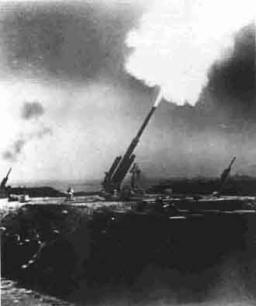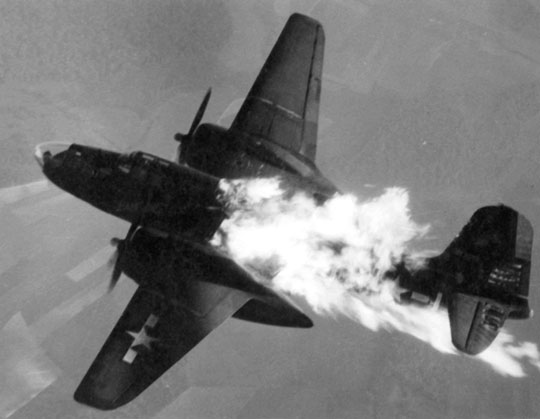The Germans produced an incredible number of Fliegerabwehrkanone or "Flak" guns to protect their troops in the field and eventually to provide a moderately effective system of radar directed Flak and searchlight systems to protect their major industrial cities, in particular those of the Ruhr valley.
Light Flak typically consisted of heavy 12.7 mm machine guns and 20 mm towed cannons that could be set up quickly around troop and armored groups for anti-aircraft protection. These guns were light, fast firing and quite effective against aircraft at low altitudes. They eventually were found all throughout the German held countries to provide protection for railroads, bridges, towns, important cross-roads and anywhere the Germans felt they needed protection. They made it quite dangerous to fly low over certain areas, such as coast lines in a slow bomber, as they would fire at almost anything flying in their area.
Medium Flak guns were typically 37 mm towed guns operated by a large crew. They were slower firing than the 20 mm guns, but had a longer range and were more deadly. They were used in conjunction with the smaller guns or at more important military installations. Their longer range allowed them to be used in the defense of German cities. Their streams of shells could be seen rising into the bomber stream as globes of yellow or red. They were contact bursting shells only.

Heavy Flak typically consisted of the highly effective and ubiquitous 88 mm cannon set up in anti-aircraft mode. By 1942 over 15,000 88 mm cannons formed the bulwark of Flak defenses for Germany arrayed in Flak belts stretching across Holland and Germany, in places 20 km thick. Many batteries were radar directed and worked cooperatively with searchlight batteries. The image above is of a radar directed battery of 88's night firing. Heavier guns of 130 mm and 150 mm were also used. The heavy Flak shells exploded at pre-set heights.

Flak was the nightmare of bomber crews as it wasn't predictable, you couldn't see it coming and if you swerved to avoid the bursts in front, you could just as easily fly into the next set of shells. They exploded in daylight with puffs of black smoke with little red interiors, and made muffled "krumppp" sounds (due to the high levels of noise in the Allied bombers). At night they flashed quickly yellow or red and disappeared. When one hit close the shards of shrapnel banged through the aircraft and pinged off of more solid members. With a direct hit from an 88 mm or larger shell the aircraft would stagger, sometimes stall, fill with smoke and screaming wounded airmen. Sometimes a wing would fold up and the bomber would go straight down in flames. Other times the entire aircraft would simply vanish in a dirty ball of fire, smoke and bits of plane and man. Many other times the aircraft and men would fly on, riddled with holes but still fighting. Only to have to try to land somewhere without lights, damaged under carriages, missing engines and wounded or dead crew. Often they bombed their targets only to die in a crash landing.
Technical Details
The 20 mm Flak guns were served by four men and were typically towed behind a
vehicle. Some were set up in Flak wagons, a light tank body with four 20 mm
cannons mounted on it. These were especially deadly to low flying aircraft. They
fired 20 mm exploding shells up to xxxx meters at a rate of ......./min.
The 37 mm medium Flak guns were served by 7 or 8 men and were towed behind a truck or the German version of a half-track. They were used to protect more valuable targets, or were in combination with light Flak guns in the field, or with heavy Flak guns in cities. They fired a 37 mm contact-exploding shell to xxxxxxxx meters at a rate of ......./min.
The 88 mm heavy Flak guns were typically set up in semi-permanent batteries intended to provide long-term protection in a Flak belt or in a city. They could be dismounted from the battery in short order and towed away as they were designed to be mobile. When directed by radar and/or working in conjunction with searchlights they were quite deadly, often downing more aircraft over a city than the German night fighters. They fired altitude-fused or proximity-fused shells up to 49,000 feet at 3 shells/min.